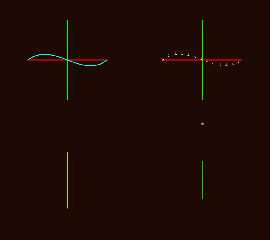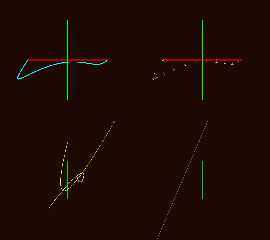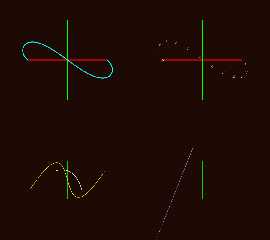|
 |
Adding the inbuilt functions: f_bezier_2d_linear()
f_bezier_2d_quadratic() f_bezier_2d_cubic() f_bezier_2d_quartic() and
f_bezier_2d_quintic() to the next yuqk release (R19).
The functions take and return single float packed 2d vectors in a
double's space for control points and return values. Calculations are at
double float accuracy internal to each functions code. The t parameter
is passed as a double.
The calculation and return mode settings:
0=<u,v> at t.
1=<u',v'> at t. (Tangent normalized)
2=<normal u,normal v> at t. ((1) rotated for normal)
3=<u',v'> at t. (Tangent / velocity)
4=<u'',v''> at t. (Acceleration / change in tangent)
5=<u''',v'''> at t. (Jerk / change in acceleration)
Attaching images showing all six calculation and return modes for
f_bezier_2d_cubic() f_bezier_2d_quartic() and f_bezier_2d_quintic().
Bill P.
Extra Detail
------------
The code approach settled upon will I believe easily map to 3D vectors
excepting the normal mode (2) calculations. Holding off though, I'd like
to play with this new 2d code for a while and, as inbuilt functions,
we'd end up working in a three, 21bit, float packed, reduced range for
the easy 3D adoption.
---
IIRC, Bald Eagle asked whether the derivatives weren't lower orders of
the Bezier curve itself. I currently believe the answer to be, yes, with
qualifications.
First, there are compensating factors for each derivative order based
upon the initial Bezier curve:
Quadratic derivative factors:
' --> 2
'' --> 2
''' --> DNA
Cubic derivative factors:
' --> 3
'' --> 6
''' --> 6
Quartic derivative factors:
' --> 4
'' --> 12
''' --> 24
Quintic derivative factors:
' --> 5
'' --> 20
''' --> 60
I used 1/(factors above) multipliers to better view the raw 1st, 2nd and
3rd derivative value curves(*) (modes 4,5 and 6) together. The
derivative value curves(*) tend to get much larger as the derivative
order increases.
Second, some algebra is required to come up with the new P' factors for
each derivative Bezier curve.
(*) - The curves are showing the entire sample set of values as spheres.
The strict sphere(t) curve may have folds where parts of the apparent
curve are getting retraced.
---
Post a reply to this message
Attachments:
Download 'f_bezier_2d_cubicstory.png' (18 KB)
Download 'f_bezier_2d_quarticstory.png' (31 KB)
Download 'f_bezier_2d_quinticstory.png' (30 KB)
Preview of image 'f_bezier_2d_cubicstory.png'

Preview of image 'f_bezier_2d_quarticstory.png'

Preview of image 'f_bezier_2d_quinticstory.png'

|
 |




![]()